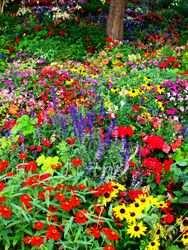
A lush and colorful garden can transform your landscaping from drab to fabulous. But if it’s your first time gardening, you may have some questions about the different types of plants available. Of the two primary categories, perennials and annuals, many gardeners prefer perennials because they return year after year. Here are the answers to four frequently asked questions using about perennials in landscaping.
Perennial Flowers FAQ
When do they bloom?
Every variety has a bloom season. Some, such as the veronica, flower in spring. Others, such as the potentilla and Russian sage, bloom in summer and fall, respectively. Including a mixture of each ensures your garden is colorful year-round. Depending on the variety, flowers may bloom anywhere from two weeks a year to three months. Keep in mind it is completely normal for perennials not to bloom in their first season.
When should they be cut back?
 Most perennials require trimming in the fall as soon as the temperature dips. Cutting back withering plants before the winter prevents diseases and pests from invading the roots. This is particularly true of mildew-prone plants, such as peonies and hostas. However, plants such as coneflower and sedum don’t necessarily require trimming. Keep these full to provide visual interest during the winter. Their seeds can also provide food for birds in the cold months.
Most perennials require trimming in the fall as soon as the temperature dips. Cutting back withering plants before the winter prevents diseases and pests from invading the roots. This is particularly true of mildew-prone plants, such as peonies and hostas. However, plants such as coneflower and sedum don’t necessarily require trimming. Keep these full to provide visual interest during the winter. Their seeds can also provide food for birds in the cold months.
How do I control growth?
Perennials get larger every year until they reach their full size, and some will spread as well. Keep your landscaping from overgrowing by dividing plants. Dig up the clump of roots, divide it into sections, and replant the segments in different spots. The frequency with which you do so will depend on the growth rate, but generally, every three to five years will suffice.
Can I plant annuals with perennials?
Annuals die every year, so these varieties need to be replaced each spring. It’s a good idea to mix annuals and perennials to maintain color and variety in your flower beds. However, keep sufficient distance between them, as perennial root systems are deep and broad to acquire adequate nutrients for sustained growth. The ideal spacing depends on the varieties, as each has a unique root development pattern.
For help planting perennials and creating a head-turning garden, turn to the landscaping contractors at Montana Gardens in Kalispell, MT. Not only can they provide flowers that complement the rest of your landscape, but they can also build a retaining wall to frame them and prevent erosion. Call (406) 250-4950 or visit the website to learn more about how they can make your property beautiful.
About the Business
Have a question? Ask the experts!
Send your question

